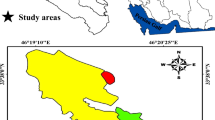Abstract
To recognize the impacts of soil acidity on quantitative and qualitative conditions of broadleaf and coniferous trees in Syyahkal watershed region of northern Iran, hand-cultivated adjacent stands of different species of Pinus taeda, Acer insinge,and Alnus subcordata were compared. To gather general information about the soil type in each site, one profile and in total five soil profiles were dug, identified, and classified. In each site 35 individual plots have been selected and thus from all 175 plots available vegetative characteristics of above said tree species including height, diameter and volume have been determined. In order to determine the soil characteristiscs in each plot and based on our previous knowledge, samples from two specific horizon depths (0–15 cm., and 15–30 cm.) were collected. Then, in total of 135 samples specific chemical analyses of concern (pH, N.K.P) were carried out. Next, based on appropriate statistical studies (Student t-test, Fisher F-test, or ANOVA, Tukey test or HSD and regression analysis) the relation between vegetative characteristics of forest trees and different soil parameters in each adjacent sites have been compared. This comparison clearly showed that the hand-cultivated stands do not share similar vegetative characteristics status and in fact due to past thinning nurturing operations Pinus taeda has gained the most volume in acre. Statistical tests reveal that an increase in the amount of soluble nitrogen as a nutrient substance with regard to the vegetative parameters for all three plant species involved translates into a direct dependent relation. This means that an increase in tree diameter, height, and volume is expected wherever more concentrations of soluble nitrogen exists. The soil profile descriptive tables clearly show that Pinus taeda has taken root deep in the soil due to the lack of nutrients at soil surface layers. Thus, it would not be logical to suggest the re-plantation of this species in ruined forested areas of interest.
Similar content being viewed by others
References
Abdollahzadeh, K. Statistics Practical Conseptc. Ayyezh Press, 205–310, 2000
Amidi, A. and M. Vahidi Asl. Mathematical Statistics. University Press, 916: 480–565, 2000
Attiwill, P.M. and M.A. Adams. Tansley Review No. 50: Nurtrient Cycling in Forests. New Phytologist, 124(4): 561–582, 1993
Bandel, V.A. and B. James. Basic Principals of Soil Fertility I: Plant Nutrients. University of Maryland. Academic Press, 1–14, 2000
Baul, T. and D. Fricker. Phosphorous and Potassium as Plant Nutrients in Forest Soils. Forest Sci., Am. G., 147: 15–26, 1969
Bickelhaupt, D. Soil pH: What it means. Suny College of Environmental Science and Forestry. Forest and Natural Resources Management Bulletin, 1–2, 2003
Brady, N. C. The Nature and Properties of Soils (Ninth Edition). MacMillan Publishing Company, 189–222, 1985
Carter, D.L. Change in Forest Nutrient Pools: A Decade of Forest Health Monitoring in Canada. Soil Sci. Am. G., 101: 193–198, 1993
Firoozan, A. The Survey of Thinning Process upon Qualitative and Quantitative Variables in Pinus taeda Stands of Lahidjan Region. College of Agriculture and Natural Resources, IAU press, 101–109, 2001
Jamaiei, M. and H. Jaldani. Determination of Volume in Hectare of Alnus subcordata in Syyahkal Kerfposhteh Forest. College of Natural Resources, IAU Press, 25–33, 1998
Jokela, E.J. Pattern of Nutrient uptake by Pinus taeda. Forest Sci. Am. G., 171: 78–84, 1993
Lilley, W.D. The Forest Nutrient Cycle. UMCE Bulletin No. 7029: Forestry Notes, 1–3, 2003
Mckenzie, R. Soil pH and Plant Nutrients: What is the Connection? Agri-News, 1–3, 2003
Montgomery, A.A. Declining Forests on Acid Soils. Soil Sci. Am. G., 330: 15–31, 1995
Nikoukar, M. Engineering Statistics. Azadeh Press, 4: 133–160, 1997
Pitchett, W.L. and R.F. Fisher. Properties and Management of Forest Soils (Second Edition). John Wiley & Sons, New York, 35–62, 133–159, 1987
Sagaan, K. We Need Forests. Yunesco Press, Payam Magazine, 224(20): 10–11, 1990
Singer, M. and D. Munns. Soils: An Intoduction (Third Edition). Prentice Hall Publications, 270–320, 1996
Soil Institute of Iran. Criteria for Making a Soil Profile Description in Iran, 494: 1–89, 1977
Sokal, R.R. and F.J. Rohlf. Biometry (Second Edition). W.H. Freeman and Company, 128–601, 1981
Zareh, H. and H. Habashi. Alnus: The Ecological Species of Northern Forests. Journal of Forests and Rangelands Organization, 48: 55–63, 2000
Zarrinkafsh, M. Forest Pedology: Interactions of Plants and Soils. Journal of Forestry, 49: 131–134, 2001
Zobeyri, M. and M. Nomeyrian. Determination of the Most Appropariate Statistical Network Dimensions in Hand-cultivated Forests of Pinus taeda. Natural Resouces Magazine, 51(2): 25–33, 1998
Zobeyri, M. Statistical Sampling in Forest. Tehran University Press, 2238: 202–400, 1994
Author information
Authors and Affiliations
Corresponding author
Rights and permissions
About this article
Cite this article
Khorasani, N., Keshavarz, A. & Adeli, E. Impacts of soil acidity on qualitative and quantitative conditions of broadleaf and coniferous trees. Int. J. Environ. Sci. Technol. 1, 177–189 (2004). https://doi.org/10.1007/BF03325831
Published:
Issue Date:
DOI: https://doi.org/10.1007/BF03325831



